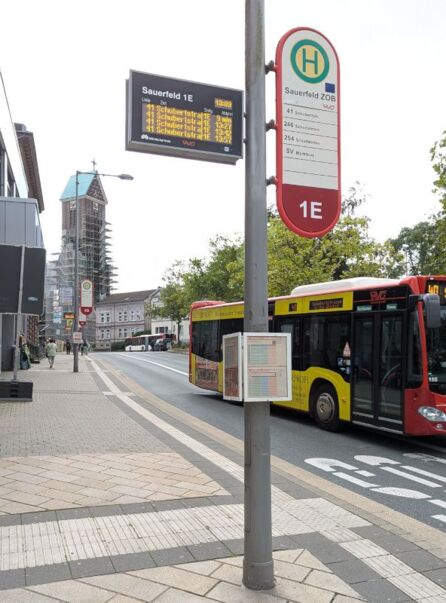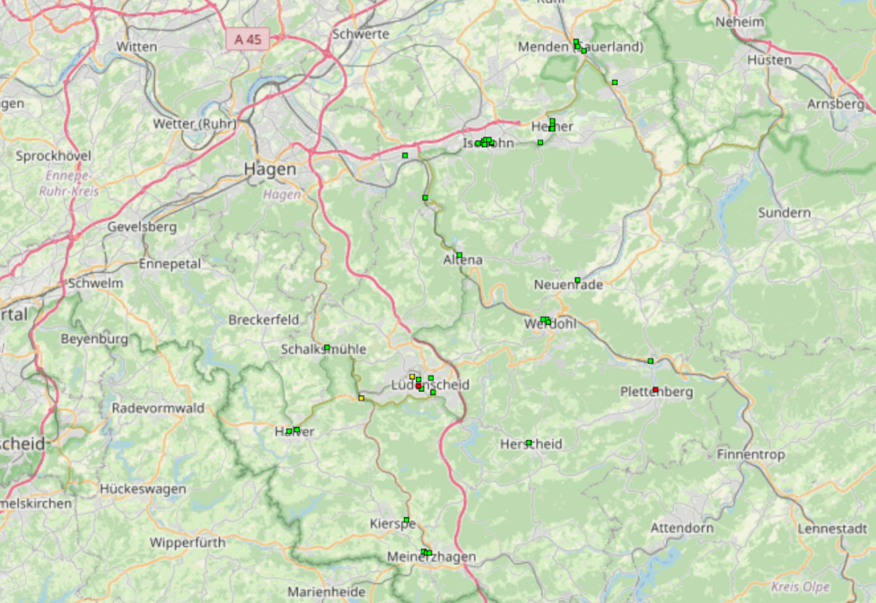MVG Märkische Verkehrsgesellschaft improves efficiency and service quality through IoT Monitoring
Challenge
- Malfunctions in passenger information systems (DFIs) impact service quality
- High workload due to the need for on-site troubleshooting and repair
- Lack of real-time insights hinders preventative action
Why Checkmk
- Out-of-the-box coverage with numerous plug-ins and specialized agents
- Full visibility into the health status of DFIs
- Real-time transparency supported by a NagVis map visualization
Results
- IoT monitoring significantly reduces Mean Time to Resolution (MTTR) and prevents disruptions
- Improved service quality due to higher availability of DFIs
- Reduced workload for the technical team, saving time and effort
About MVG Märkische Verkehrsgesellschaft
-
Industry
Transport and Traffic
-
Headquarters
Lüdenscheid, Germany
-
Employees
Approx. 500
-
Monitored hosts/services
400 / 12,000
-
Solution
Checkmk Enterprise
Challenge
Heavy workload and impaired service quality
At Märkische Verkehrsgesellschaft (MVG), advanced technology is the backbone of a reliable and efficient public transport system centered on passenger satisfaction. One critical component is the digital Passenger Information Systems (DFIs) installed at approximately 50 bus stops across the Märkischer Kreis district. These systems provide real-time updates such as departure times.
However, frequent disruptions and failures plagued the DFIs, and resolving issues required on-site repairs. Given the geographical spread of the Märkischer Kreis district, even traveling to affected sites was time-intensive. These disruptions not only increased the workload for MVG employees responsible for diagnosing and repairing failures but also negatively impacted customer service.
MVG aimed to resolve DFI failures quickly and efficiently or prevent them altogether. Based on the company’s previous positive experience using Checkmk for IT monitoring, MVG decided to adopt this software solution for DFI monitoring. Checkmk had repeatedly demonstrated exceptional flexibility in adapting monitoring tasks. For instance, MVG used it for needs-based adjustments to solve recurring issues or to streamline time-intensive tasks. This included activities like patch management or remote server maintenance, ensuring maximum security and service quality with minimal effort.
Solution
Adaptable and rapid IoT monitoring
In collaboration with IT Südwestfalen – a long-term IT service partner and Checkmk distributor – MVG implemented a comprehensive monitoring system for DFIs. These systems rely on single-board computers that communicate with the central DFI server at MVG headquarters via cellular connections. Key IoT functions were enabled by BusyBox, an integrated tool providing compact UNIX utilities, a Secure Shell, and a DHCP server.
The decision to use Checkmk proved especially advantageous for systems using BusyBox. Since a dedicated agent for BusyBox was already available, the project team could get started immediately. In a specially designed test environment, the team initially retrieved system data such as disk usage, CPU temperature, and connectivity.
MVG leveraged the extensive customization capabilities of Checkmk to further adapt the monitoring solution, achieving deeper insights into DFI status. Initial steps included deploying Ping tests to verify connectivity between individual DFIs and the DFI server. Subsequent integrations added plug-ins to monitor mobile cell IDs, LTE signal strength, signal quality, and synchronization accuracy with server time.
Finally, using the GPS coordinates of bus stops and collected metrics, the team developed a NagVis map within Checkmk. This map offers a clear and centralized visual overview of the status of all DFIs, enabling real-time monitoring.
Results
Raising customer satisfaction and enhancing team efficiency
Through DFI monitoring with Checkmk, MVG maintains constant oversight of the DFIs‘ health state. Incidents are immediately detected, and the responsible specialist team is automatically notified via email when action is needed. Simultaneously, the affected bus stop is marked in red on the NagVis map. This visual representation allows for quicker understanding of problems and technical interdependencies, further facilitating diagnostics. For instance, if all bus stops in a specific district light up red, it likely indicates a widespread LTE outage. Monitoring signal strength within the cellular network also clarifies whether the issue stems from DFI technical faults or problems with the mobile service provider when DFIs lose their connection to the DFI server.
MVG can now identify disruptions early and take proactive measures to prevent them. Metrics such as signal quality, time deviation, or CPU temperature can be visualized over a defined period and analyzed within Checkmk alongside other parameters, such as error rates or location. This enables MVG to determine the conditions under which problems arise, such as a fan failure indicated by an increase in CPU temperature. Based on these insights, MVG can establish additional thresholds within Checkmk to trigger alarms, allowing the DFI team to take timely countermeasures.
-
Improved service quality
-
Higher DFI availability
-
Reduced time and workload
-
More efficient use of resources
-
Relief for specialist staff
The project has been a resounding success overall. Service quality has improved thanks to increased DFI availability and much faster issue resolution. Time and labor efforts have been significantly reduced, relieving the DFI team. Extensive on-site work is now the exception. By utilizing an intelligent monitoring solution like Checkmk, MVG can make more efficient use of its resources and reduce the workload on its specialist team. Given the current shortage of skilled workers, this approach ensures that the existing tasks can continue to be effectively managed in the future.
Checkmk makes our work easier by eliminating time-consuming processes and letting us focus on valuable tasks.
About the customer
MVG Märkische Verkehrsgesellschaft GmbH, based in Lüdenscheid, is the municipal transport company serving the Märkischer Kreis district. Checkmk was introduced in 2018 as part of a data center modernization effort. Since then, MVG has consistently expanded its IT monitoring with Checkmk, largely due to the solution’s high customizability. Currently, around 12,000 services and 400 hosts are monitored with Checkmk Enterprise in a distributed monitoring setup with a central site and two remote sites at satellite locations.

